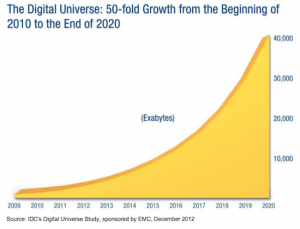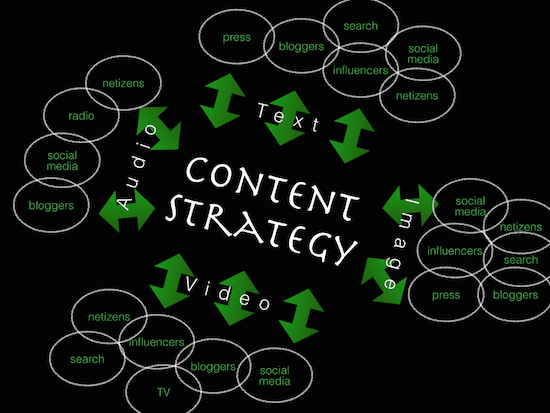What’s missing in your content strategy? Great content? Available assets? Sufficient resources? Original storytellers? Appropriate platforms? Enough fans and followers? While crafting a robust content strategy already takes a certain skill, I believe that creating the content is just the first half of the story. The second half is going to be even more challenging: getting the content out there.
 The tsunami of content
The tsunami of content
It is said that, by 2020, the amount of data (i.e. content) will increase at least 6x. In other words, to paraphrase Mark Schaefer, who talks about “content shock,” there will be one new Internet added every year from now until then. {Tweet this!} IDC’s Digital Universe study is even more aggressive, saying that data will increase 10x by 2020. How much of that data is accessible, readable and useful remains to be seen, although services like Shodan (a search engine specifically for the Internet of Things) will certainly prosper and improve. This begs the big question:
How on earth will your data and great content be found?
Companies that understood the digital revolution best and earliest, turned their attention to creating and publishing engaging content. Since Google likes to promote legacy, a blog that has been around for a long time [and whose content is still being refreshed, of course] will get favorable attention in the search results. If nothing else, this does show that first movers will have an advantage. Nonetheless, getting your content to be exposed to the right people will become THE major challenge over the next few years. {Tweet this!}
Creating a strong content strategy
Whether in a B2B, B2G or B2C type environment, creating valuable, trustworthy and contextually relevant content is indisputably important. {Tweet this!} I like this definition of a content strategy, by Erik Hartman at CMS Wire:
A content strategy is a plan that describes how the goals of an organization can be met by providing valuable information to its audience.
In this context, companies will need to address three important points:
- Clarifying the overall purpose and strategy
- Defining and enhancing the content proposition
- Discovering and unleashing the creative sources within and without the organization
From a strictly functional point of view, there are four classes of content: text, image, video and audio. All still need a heavy anchoring in appropriate tagging in text in order to be findable on the search engines.
 As the wave of content turns from plethoric to overwhelming to demoralizing, the search engines are going to have a titanic struggle to keep up providing its customers with successful and satisfying search results. Inevitably, the Googles of the world will need to find ever more sophisticated methods of delivering the right content for each search request. Netizens will inevitably evolve as well to become more crafty at finding what they are looking for, especially considering the burgeoning rise of the mobile (where we tend to be more task-specific). Social media is bound to play a key role as a layer or filter in providing the netizen better quality of results. Vertical search engines are bound to appear. It’s likely the meta search engines might try to fight their way onto the scene; i.e. taking the best results of Yahoo, Google and Bing’s first page…
As the wave of content turns from plethoric to overwhelming to demoralizing, the search engines are going to have a titanic struggle to keep up providing its customers with successful and satisfying search results. Inevitably, the Googles of the world will need to find ever more sophisticated methods of delivering the right content for each search request. Netizens will inevitably evolve as well to become more crafty at finding what they are looking for, especially considering the burgeoning rise of the mobile (where we tend to be more task-specific). Social media is bound to play a key role as a layer or filter in providing the netizen better quality of results. Vertical search engines are bound to appear. It’s likely the meta search engines might try to fight their way onto the scene; i.e. taking the best results of Yahoo, Google and Bing’s first page…
Content Strategy End Game = Distribution
The issue is that, after branded digital content is created, it must be distributed. Until reasonably recently, content seems to have had three ways to cut through the noise (used in combination):
- paid online distribution (sponsored stories, Google ads…)
- mass media (whether via ads, PR…) driving to online
- more or less seeded virality via social media…
But, with the accelerating flow of content, brands will need to find alternative ways to pierce through the noise, without paying through the nose (i.e. via paid media). And to avoid the pitfalls of dumb push messaging, brands are going to need to find trampolines and receptors to help qualify and approve of its content in an effort to gain social proof. Distribution of content is an entirely new avenue for advertising agencies who have historically had units specialized in ”media buying.” For many big brands, less able to foster a community of support, there is bound to be a marketing model anchored on media buying and paid distribution. For other more astute brands who have fostered a higher purpose, engaged more intently its employee base and carefully constructed a trustworthy relationship with key influencers and online media, they should be able to take advantage of a deeper, more powerful distribution based on shared values, social proof and sharing.
If your brand has not defined a real “why” (as Simon Sinek would say) and if your content does not leverage your brand’s purpose, the hard truth is that paid media is likely the only effective path out there. {Tweet this!}
Do you agree that distribution will be a big challenge over the next five years?










